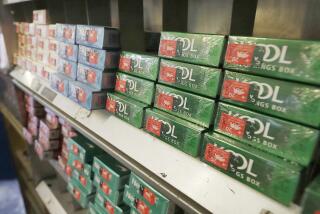Taishan’s U.S. well runs dry
DOWN a narrow red dirt road past rice paddies, water buffaloes and abandoned farmhouses is the dab-sized town of Wo Hing. Locals know it as Lop Cham Kee village, or Los Angeles village.
Seventy years ago, young men in this desperately poor region a few hours west of Hong Kong’s high-rises emptied out of Wo Hing to cross the Pacific and try their luck in America. Many would end up on Hill Street or Broadway as cooks and waiters or open their own restaurants in the San Gabriel Valley. Their children would become engineers and even city councilmen. Their decision to leave still dominates the lives of those who stayed behind, for better and for worse.
Wo Hing, like many villages in the encompassing city of Taishan, has survived through a combination of backbreaking farming and handouts from America. That dependency on wah kiu -- overseas Chinese -- has left the villagers vulnerable, however: In the same way the old remnants of L.A.’s Chinatown are fading away, so is the generation from Wo Hing that can be counted on to deliver cash, including donations to build roads and schools.
It clouds an already uncertain future for the 40 residents of this village where water is still fetched from wells and meals cooked over wood fires. They’ve spent recent years watching the urban centers creep closer to their fields and their children leave for factory jobs.
Farmers all over China are struggling to adapt to the nation’s rapid industrialization, but it is especially hard for the inhabitants of many villages in Taishan, who have to learn to move on without the financial advantage they’ve long enjoyed from America.
“Every one here has some family overseas,” said a 60-year-old retiree lounging on a bamboo recliner in the nearby village of Moy Family Garden, giving only his surname, Moy. “I have relatives in Chicago and New York. I’m still waiting for my turn. But I don’t have to work here. If I go to America now, who knows? I may have to work hard.”
Mei Weiqing, a native of Taishan and wah kiu scholar at Wuyi University in the neighboring city of Jiangmen, said the generosity of those who left has both benefited and hindered Taishan.
“The overseas Taishanese are much more hard-working,” he said. “The locals have become lazy. It’s a serious problem. In U.S. society, the Taishanese had to live in the lowest end of society. They took the worst jobs. In Taishan, the men won’t even consider doing the washing or cooking. American Taishanese learned to do these things to survive.”
TO villagers, the wah kiu are heroes. They are feted with whole roast pigs when they visit. On display in the village hall is a marble plaque that lists the amount of money each wah kiu has donated. Villagers help maintain the homes of those who left, bowing with incense twice a month before shrines to pay homage to their ancestors.
“I treat it like my own house,” villager Jie Moi Cin said about caring for the home her recently deceased uncle in Los Angeles left behind in the 1940s. “Even if they never send money back again, we couldn’t abandon it. But after the old ones pass away, the young ones may not know what to do. Maybe they’ll forget about us.”
She has reason to be concerned. The visits come at a trickle compared with the 1980s and ‘90s, when the wah kiu were comfortably retired and ready to share their wealth. Back then, minibuses would drop off dozens of the Americans to a throng of applauding villagers. Today, villagers get phone calls or letters every few months informing them that another aging relative has died. They know that the children and grandchildren of the wah kiu have little to no connection to Wo Hing.
This is how it has worked in Taishan since men started leaving more than 200 years ago. The city and its many villages have staked a part of their livelihood on the goodwill of their overseas countrymen, whose history is rooted deeply in the development of America. They were gold-rushers, they built America’s Pacific railways, and they established the first Chinatowns from New York to San Francisco.
Until the 1980s -- when Taiwanese and Hong Kong Chinese began to arrive en masse -- Taishanese was the chief dialect heard in most Chinatowns. It was the culture that gave America egg foo young and chop suey.
Even today, Taishan proudly bills itself as the “No. 1 Home of Overseas Chinese.”
There are 1 million residents in Taishan, but 1.3 million Taishanese in Hong Kong and abroad. An estimated half a million Chinese Americans are of Taishanese descent.
Along with those who fled Taishan for Hong Kong when it was administered by Britain, American Taishanese have led the charge here in helping pay for hospitals, colleges, senior centers, highways, bridges, towers and even the Overseas Taishanese Museum. “American building” is part of the everyday vernacular, and looking in any direction from the city center, it’s impossible not to find one.
“In Taishan, almost everyone has a connection to North America,” said Mei, the professor. “Every year, more than 8,000 Taishanese continue to leave, mostly to America and Canada. They will try any way to go abroad.”
A history of civil strife and poor terrain for farming has always hobbled Taishan and tempted the poorest to leave. The nearby South China Sea beckoned daring men to take their chances elsewhere to feed their families.
This proved bountiful for Taishan for much of the 20th century. Before World War II, many sojourners would return with gold and build towering gothic-styled buildings in their home villages. They erected watch towers to fend off bandits that menaced the area. By Chinese standards of the day, Taishanese related to wah kiu were rich.
Signs of those days now litter the countryside. Not far from Wo Hing, Moy Family Garden rises out of the rice paddies and duck ponds like an ancient ruin. The 108 three-story European buildings with pillars and Venetian facades are squeezed together to form a rectangle with a courtyard in the center.
But in the village itself, three-quarters of the dirt-blackened buildings are now boarded up. Chinese characters above many storefronts have been worn away by time. In the remaining buildings, locals in flip-flops play mah-jongg while chickens as big as turkeys cluck at their feet.
Since national economic reforms began in 1978, the region around Wo Hing has been transformed. On the country road here, dozens of sprawling factories making furniture and pots and pans swallow space next to chicken farms and lumber yards. Wo Hing, on the other hand, has largely remained the same since it was built in 1902. The buildings aligned almost perfectly perpendicular to one another are separated by dirt path alleyways roamed by packs of ragged dogs.
Against the front wall of each home’s living room are tall red- and gold-colored shrines on wooden platforms. It’s a prime location where Americans might elect to place their flat-screen TVs, but for the villagers, it’s where you honor your ancestors.
Paying respects to the place where past generations were born and spirits are still believed to be is what compels Arcadia resident William Wong to return to Wo Hing every other year.
Wong was 14 when he left Taishan in 1947. He now heads the region’s overseas association in L.A.’s Chinatown. When the group formed decades ago, there were 2,000 members. Today, there are half that many.
“The younger guys don’t join, and we keep losing the senior members,” said Wong, 74, a retired Los Angeles County engineer who carries packets of red envelopes stuffed with $10 bills to give to villagers when he visits. “We’re trying to bring some college and high school students out there this summer to show them their roots.”
Wong returned to Wo Hing for the first time in 1994. The home he was raised in had partially collapsed. For $10,000, he had it rebuilt. It’s now the only modern structure here, covered in white and green tiles and boasting a stainless-steel front door.
NOT everyone feels the tug. Ben Wong’s parents grew up in the village, but he’s only been there once for a brief visit in 1980. The former West Covina councilman, who is not related to William Wong, said he and his children were too immersed in their lives in America to contribute the way his parents did.
“The next generation came along and we didn’t find ourselves in that same position as our parents,” said Ben Wong, 56. “I got married and had kids and a career. There’s still some connection, but it’s always difficult for me. I never found time to bring my kids out there, and I regret that to an extent.”
The villagers who remain in Wo Hing say they don’t have close enough relatives in the United States who can sponsor them. Otherwise, many say, they’d be gone by now.
Some, like 88-year-old Wong Kong Chuan, had their chance to leave, but misfortune got in the way.
“I’ve been once,” he said, explaining that he tried to go to the U.S. to meet relatives in Stockton.
“I tried, but they turned me away,” he said of the border guards.
That was 1931. He had journeyed with his uncle, who made it through. That uncle would start a family in the U.S. Pictures of his children standing in front of Griffith Observatory hang on Wong’s wall.
“He used to send me $200,” he said, losing his breath from the effort of standing and talking. The uncle is dead now, and Wong is still here in Los Angeles village.
*
Gu Bo of The Times’ Beijing Bureau contributed to this report.
More to Read
Start your day right
Sign up for Essential California for news, features and recommendations from the L.A. Times and beyond in your inbox six days a week.
You may occasionally receive promotional content from the Los Angeles Times.






